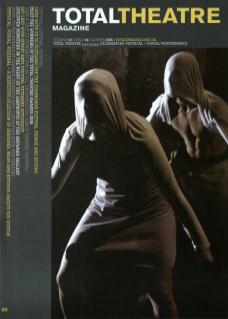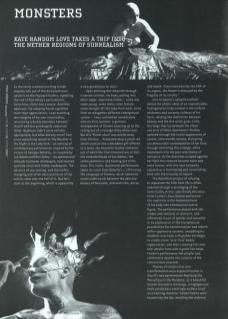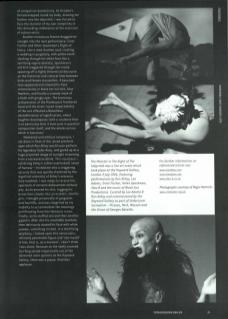As the newly crowned Sun King strode majestically out of the darkened room upstairs at the Hayward Gallery, signalling the end of Ron Athey’s performance, Solar Anus, there was a pause. And then applause. My clapping hands signalled more than appreciation; I was asserting the integrity of my own corporeality, reinstating a bodily boundary between myself and this grotesquely seductive Other. Applause didn’t seem entirely appropriate, but what did any more? Ever since submitting myself to The Monster in the Night in the Labyrinth – an evening of contemporary performance inspired by the visions of Georges Bataille, co-curated by Lee Adams and Ron Athey – my spectatorial defaults had been challenged, had seemed quaintly naive and totally inadequate. The absence of any seating, and the swiftly changing and often obscured focus of the action, were only the half of it. But let’s start at the beginning, which is apparently a very good place to start.
Upon entering the Labyrinth through a narrow corridor, my body jostling into other eager, expectant bodies – some old, some young, some male, some female, some straight off the tube from work, some from an altogether different underground system – I was confronted immediately with my first monster: a glorious arrangement of flowers towering up to the ceiling out of a strange milky white vase. But this ‘flower show’ was worlds away from Chelsea... Presented atop a plush red velvet cushion like a decadent gift offered to a lover, the beautiful marble container out of which the lilies bloomed was in fact the contorted body of Lee Adams, the stems jammed in and busting out of his anus. This static, durational performance takes its name from Bataille’s c.1929 essay The Language of Flowers, which identifies inextricable bonds between the delicate beauty of blossoms, and eroticism, decay and death: ‘Even more than by the filth of its organs, the flower is betrayed by the fragility of its corolla.’
Just as Adams’s splayed arsehole belied the phallic ideal of an impenetrable, homogeneous body evoked in the uniform whiteness and uncanny stillness of his form, refuting the distinction between beauty and the dirt which gives it life, the twigs that lay beneath the silken sea skirt of Helen Spackman’s Perdita speared through the initial appearance of serene, otherworldly beauty, disrupting our pleasurable contemplation of her form through animating this strange, white mannequin into the pain and shame of existence. As the branches scraped against her flesh the creature became more and more human, with this very humanity exposed as a humiliating and constricting bind with the brutality of nature.
The Bataillean project of refusing to repudiate the filth from life is often enacted through a privileging of the lower bodily strata, specifically the anus. Ernst Fischer’s Anus Domini performed this explicitly in the metamorphosis of his body into a fantastical hybrid figure. The performance played with the modes and methods of restraint, and referenced issues of gender and sexuality in its exploration of the transgressive possibilities for transformation and rebirth within oppressive systems. Swaddling his doubled-over body with grubby bandages to create a new ‘arse-first’ bodily organisation, and then crowning this new anti-phallic form with a giant fish head, Fischer’s performance felt playful and celebratory despite the violence of the constrictions enacted.
Themes of constriction and transformation were explored further in Stav B’s new performance Realising the Marvellous in the Mundane, as a beautiful woman dressed in stockings, a negligee and heels produced a seemingly endless scarf on a knitting machine. Golden hearts were tossed into the sky, extolling the violence of compulsive domesticity. As Ariadne’s thread wrapped round my body, drawing me further into the labyrinth, I was forced to face the monster of my own complicity in this disturbing celebration of the eroticism of subservience.
Another monstrous femme dragged me straight into the next performance, Ernst Fischer and Helen Spackman’s Flight of Fancy. Like a mad drunken aunt crashing a wedding in purgatory, with yellow teeth slashing through her white face like a terrifying vagina dentata, Spackman’s old bird staggered through the crowd, spouting off a highly theoretical discourse on the historical and cultural links between birds and female storytellers. A besuited man appeared and covered his face consecutively in black tar/oil/shit, blue feathers, and finally a comedy mask of a beak with googly eyes. The humorous juxtaposition of the flamboyant feathered head and the strait-laced respectability of the suit effected a Bataillean destabilisation of signification, where laughter decomposes ‘with a virulence that is so pernicious that it even puts in question composition itself, and the wholes across which it functions.’
Weakened and without composure, I sat down in front of the raised platform upon which Ron Athey would soon perform his legendary Solar Anus, and gazed up at a huge projected image of sunlight streaming from a tattooed arsehole. This visual pun – exhibiting Athey’s (often overlooked) sense of humour – tricked me into a sniggering security that was quickly shattered by the dignified solemnity of Athey’s entrance. Duly humbled, I was ready to receive this spectacle of extreme debasement without pity. As he pierced his skin, tugging his brows then cheeks into an ecstatic, horrific grin, I thought prosaically of gargoyles and facelifts, and was chagrined by my inability to accommodate the meanings proliferating from this fantastic vision. Finally, as he stuffed one and then another gigantic dildo into his insatiable arsehole, then deliriously dusted his face with white powder, something clicked. In a mortifying epiphany, I looked upon this narcissistic, infinitely penetrable figure and ‘saw myself in him, that is, as a monster’. I don’t think I was alone. Because as the newly crowned Sun King strode majestically out of the darkened room upstairs at the Hayward Gallery, there was a pause. And then applause.
The Monster in The Night of The Labyrinth was a live art event which took place at the Hayward Gallery, London 3 July 2006, featuring performances by Ron Athey, Lee Adams, Ernst Fischer, Helen Spackman, Stav B and the music of Black Sun Productions. Curated by Lee Adams & Ron Athey and commissioned by the Hayward Gallery as part of Undercover Surrealism - Picasso, Miró, Masson and the Vision of Georges Bataille.
For further information on referenced artists see: www.ronathey.com www.leeadams.net www.stav-b.co.uk Photographs courtesy of Regis Hertrich: www.cremaster.org.uk


